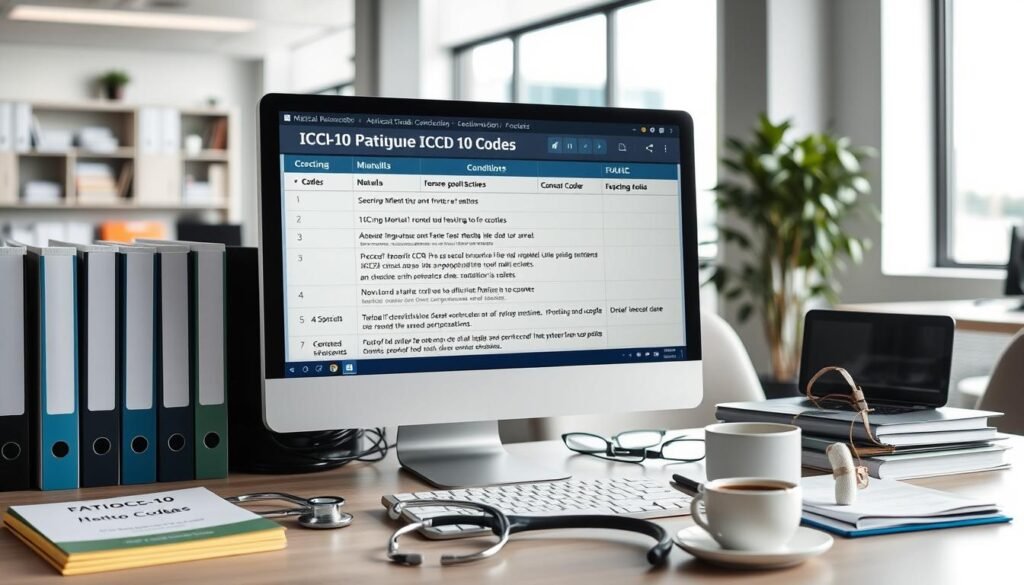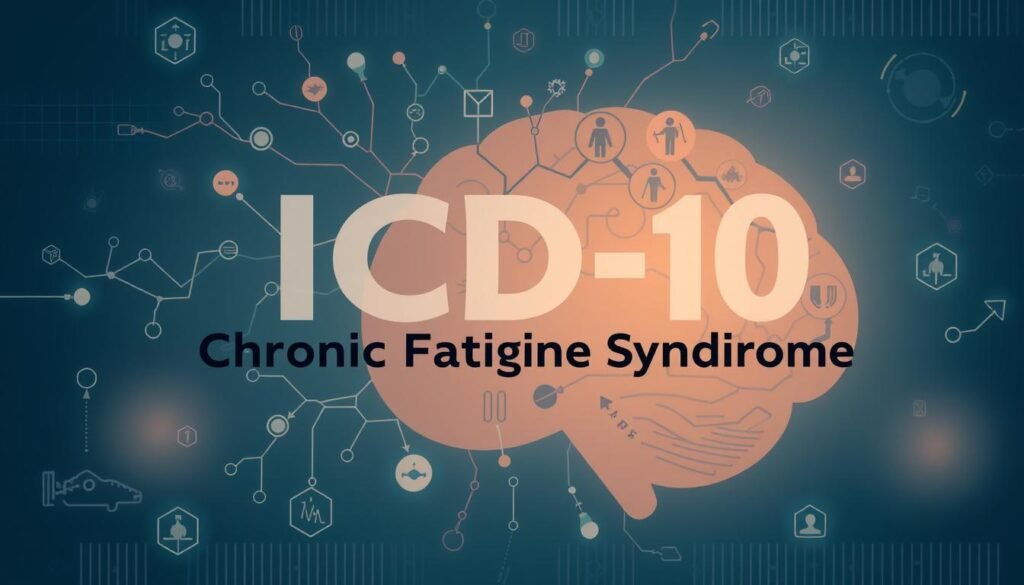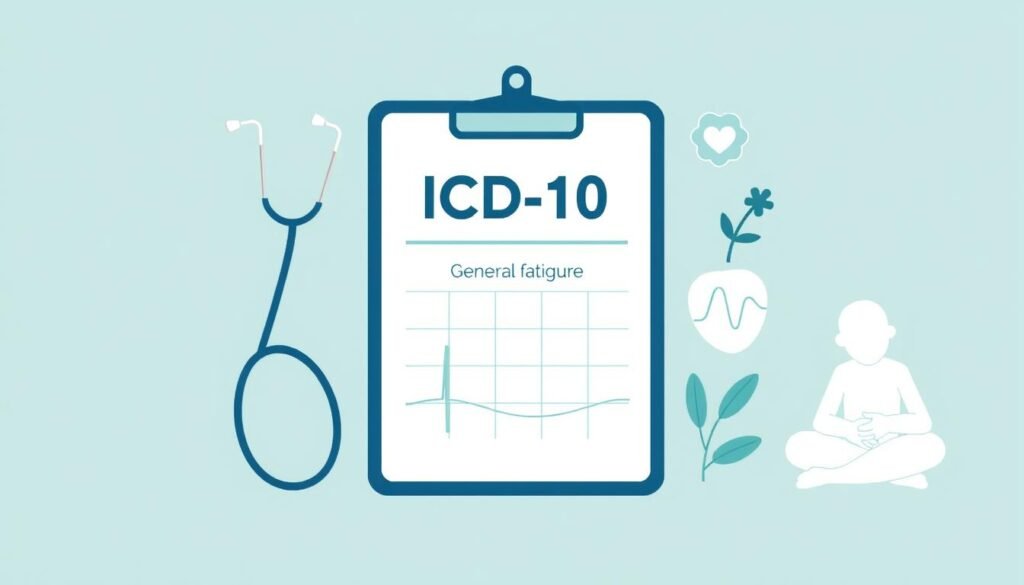Did you know about 60% of adults feel so tired it affects their day? This fact shows why it’s key to correctly name and code fatigue-related conditions with ICD-10. Fatigue isn’t just feeling tired for a bit. It can really change how well a person lives and works. So, using the right codes is super important for getting them the right help and for billing. The ICD-10 codes let doctors mark down exact health issues. This means patients get better care.
When we look at common ICD-10 codes for fatigue, R53.83 is a main one for many fatigue issues. This part is about understanding fatigue better and how to code it. It helps doctors give the top treatment.
Key Takeaways
- Fatigue affects over 60% of adults, influencing their daily functions and health.
- Accurate coding for fatigue-related conditions is critical for effective treatment and billing.
- The ICD-10 provides standardized codes that help in documenting fatigue diagnoses.
- R53.83 is a significant code for identifying unspecified fatigue.
- Better understanding of chronic fatigue ICD-10 can enhance patient management.
Understanding Fatigue-Related Conditions
Fatigue can be complicated, with symptoms stemming from various health problems. It appears in both short-term and long-lasting forms. Understanding fatigue’s effects is key to diagnose and treat it right.
Many people suffer from ongoing fatigue caused by different issues. It’s hard for doctors to pinpoint fatigue because it often coexists with other problems. Factors leading to fatigue include:
- Medical conditions such as anemia, diabetes, or thyroid disorders
- Psychological factors like depression and anxiety
- Lifestyle choices including sleep patterns and dietary habits
The ICD-10 coding system helps doctors by offering specific codes for fatigue. These codes fall under Chapter 18 (R00-R99). They let doctors record fatigue diagnoses accurately, even if the exact cause isn’t found.
Correct coding for fatigue involves understanding certain rules. There are notes that say some conditions can’t be coded together. Other notes help identify common conditions. This helps doctors choose the right ICD-10 codes for fatigue.
For various fatigue cases, the ICD-10 Code R53.83 is used. Patients with this code often feel tired all the time and lack energy. They might feel generally unwell without a clear reason. This code is important for treating patients when no other medical reason for their fatigue is found.
In short, dealing with fatigue is complex and requires understanding its many aspects. Knowing about symptoms and using the right ICD-10 codes improves patient care and leads to better health outcomes.
Importance of Accurate Coding
Accurate coding is key for getting the right funds for medical services for fatigue-related issues. It helps ensure patients get the necessary support and treatment. This way, everyone can receive the care they need.
When coding is not done right, it leads to problems. Claims may be denied and payments delayed. This can stop patients from getting the care they need. Healthcare workers must know how to code properly to avoid these issues.
For instance, new codes like for Chronic Fatigue Syndrome (G93.32) help doctors track and treat patients better. They show how understanding these illnesses has improved. With accurate coding, healthcare pros can make sure patients get the right support.
Doctors should keep up with coding updates, especially with ICD-11 around the corner. With over 72 countries adopting it, accurate coding is more important than ever. For tips on coding for fatigue, check out this resource.

Common ICD-10 Codes for Fatigue-Related Conditions
Healthcare providers need to know about codes for fatigue conditions. Correct coding helps diagnose, treat, and get payment for patients. Here are some main ICD-10 codes for fatigue issues.
ICD-10 Code R53.83: Other Fatigue
The ICD-10 code R53.83 is for other fatigue issues starting October 1, 2024. This code includes different kinds of fatigue not covered by other diagnoses. Doctors should know this code for better documentation.
ICD-10 Code R53.82: Chronic Fatigue, Unspecified
R53.82 is the code for chronic fatigue, effective on October 1, 2024. It helps classify chronic fatigue that doesn’t fit other criteria. Between 836,000 and 2.5 million Americans have chronic fatigue. The use of this code is key for accurate billing and chronic fatigue tracking.
ICD-10 Code G93.32: Chronic Fatigue Syndrome
G93.32 is for myalgic encephalomyelitis/chronic fatigue syndrome (ME/CFS). This code clears up confusion by providing a specific code for ME/CFS. It makes billing easier and helps care for people with this condition. Doctors should keep up with this code to help patients with chronic fatigue.
Using these ICD-10 codes for fatigue conditions helps doctors document and take care of patients. Knowing these codes, including ones for general fatigue and malaise, makes healthcare more efficient.
ICD-10 Code for Chronic Fatigue Syndrome
Chronic Fatigue Syndrome (CFS) is a complex, debilitating condition that greatly affects daily life. The ICD-10 code for chronic fatigue syndrome is G93.32, for myalgic encephalomyelitis/chronic fatigue syndrome. It’s vital that healthcare workers realize CFS symptoms include severe tiredness that rest doesn’t help. This is alongside neurological issues, muscle pain, thinking problems, and sensitivity to stimuli.
The ICD-10-CM coding system now more precisely addresses CFS under the updated guidelines. Before, the more general code R53.82 was used for unspecified chronic fatigue. This caused confusion about CFS’s specific traits. By using G93.32 now, medical records make a clearer distinction, improving the billing and reimbursement for chronic fatigue treatment.
Between 836,000 and 2.5 million Americans suffer from CFS, making accurate coding essential for healthcare providers. The changes in the ICD-10-CM coding system aid in clinical documentation and better data tracking. Thus, they ensure the needs of these patients are well met.

The rise of long-term fatigue after COVID-19 makes it critical for doctors to think of chronic fatigue syndrome when diagnosing. The U.S. ME/CFS Clinician Coalition calls for more awareness of ME/CFS in patients with ongoing symptoms after infection. This highlights the need to update coding practices to reflect new clinical realities accurately.
| Code | Description |
|---|---|
| G93.32 | Myalgic Encephalomyelitis/Chronic Fatigue Syndrome |
| G93.31 | Postviral Fatigue Syndrome |
| G93.39 | Other Post Infection and Related Fatigue Syndromes |
| U09.9 | Post-COVID Condition, Unspecified |
ICD-10 Code for General Fatigue
General fatigue means being tired all the time, even after resting. It can be caused by lifestyle, health issues, or stress. The ICD-10 code helps doctors document and treat fatigue properly. Knowing this code is key for patient care and billing.
Defining General Fatigue in ICD-10
The ICD-10-CM Code R53 deals with tiredness and fatigue. R53.83 is for “Other fatigue” and is a code doctors can bill. This is handy in many medical settings. It helps doctors record severe fatigue without a clear cause. This is crucial when fatigue is the main problem a patient has.
There are also ICD-10 codes for different fatigue types:
- R53.0 – Fatigue related to cancer
- R53.82 – Chronic fatigue, unspecified
- R53.1 – Weakness
- G93.3 – Fatigue after a virus
- F48.0 – Neurasthenia
- M79.7 – Fibromyalgia
ICD-10 allows for detailed record-keeping. Besides fatigue, symptoms like dry mouth (R68.2) or an unspecified headache (R51.9) can also be noted. This helps in understanding all aspects of a patient’s fatigue.

Using the correct ICD-10 code for fatigue aids in accurate treatment and billing. Being familiar with these codes helps doctors care better for patients and manage fatigue symptoms effectively.
ICD-10 Code for Sleep Disturbances
Sleep disturbances often lead to tiredness and fatigue. Knowing the right ICD-10 codes helps doctors diagnose and manage these issues effectively. There are specific codes for various sleep disorders, like insomnia, sleep apnea, and restless legs syndrome. These ensure patients get the correct treatment.
The code for insomnia is G47.0. It covers all types of insomnia, including those caused by health problems. Sleep apnea has the code G47.3. This includes primary central sleep apnea and obstructive sleep apnea, which can occur in both adults and children. Accurate coding is crucial. It helps connect fatigue to sleep problems, improving care.
Narcolepsy and cataplexy are under the code G47.4. This code distinguishes narcolepsy with and without cataplexy. For sleep issues like night terrors or sleepwalking, there’s the code G47.5 for parasomnia. This helps doctors provide specific treatments.
Movement disorders related to sleep have the code G47.6. This includes periodic limb movement disorder and sleep-related leg cramps. Addressing these symptoms is key to reducing fatigue.
There’s also a code, G47.9, for unspecified sleep disorders. It allows doctors to diagnose a wide range of sleep-related symptoms. The sleep disorder codes from G00 to G99 cover various issues.
Understanding these codes is important for handling sleep-related tiredness. To learn more about ICD-10 codes for fatigue, check out this guide.
ICD-10 Code for Malaise and Asthenia
The ICD-10 code for malaise helps doctors document symptoms like general discomfort. It’s used when patients feel unwell, often from various health issues. The R53.1 code is key for conditions such as asthenia, meaning low energy. This helps in managing patients by tailoring treatments to their needs.
The R53 category lists symptoms like fatigue that don’t fit elsewhere. With updates in 2025, it’s getting more precise. Code G93.3 is for postviral fatigue, and R53.82 for chronic fatigue.
Correct coding is vital for research and medical billing. Knowing these codes lets healthcare workers improve care for those with energy-draining conditions. This could lead to better health for patients.
Best Practices for Coding Fatigue-Related Conditions
It’s key to use best practices when coding fatigue conditions to boost patient care and ensure correct billing. First, we must gather a full history from each patient. Also, we need to look for other conditions that might affect their fatigue. By doing this, healthcare providers can use the right codes. This makes planning treatment more effective.
Utilizing Comprehensive Patient History
Knowing a patient’s complete history is critical when dealing with fatigue. We need to learn about their symptoms, health background, and life habits. This depth of information helps us code more precisely. For example, we can tell the difference between myalgic encephalomyelitis and other forms of fatigue. We look at a patient’s past infections, lifestyle, or other medical diagnoses to do this.
Identifying Coexisting Conditions
Other health issues can make diagnosing fatigue more complex. When we access a patient’s records to find these conditions, we can code more accurately. It helps to understand how issues like depression, sleep problems, or chronic pain mix with fatigue. This insight makes our coding more relevant. It also greatly improves our treatment advice.
| Condition | Symptoms | Importance in Coding |
|---|---|---|
| Myalgic Encephalomyelitis | Severe fatigue, dizziness, cognitive impairment | Specific coding improves tracking and treatment |
| Chronic Fatigue Syndrome | Pain, sensory sensitivity, fatigue | Accurate diagnosis aids in effective management |
| Post-COVID Syndrome | Fatigue, cognitive issues, physical exertion malaise | Recognizing coexisting conditions promotes comprehensive care |
Conclusion
Correct coding for fatigue is key for good patient care and top-notch healthcare. It’s important to use ICD-10 codes right, like for chronic fatigue syndrome. This makes sure patients get the right treatment and billing is accurate.
Discussing the 134 ICD-10 codes for Chronic Overlapping Pain Conditions shows something big. Patients often have various symptoms that need close evaluation. Codes for things like fibromyalgia show how complex these conditions are. Good billing practices help patients and help doctors deal with payment issues.
To wrap up, learning more about fatigue coding helps healthcare workers help their patients better. By getting better at coding, the healthcare world can better meet the needs of those with fatigue issues. This commitment leads to better care for patients, making everyone healthier.